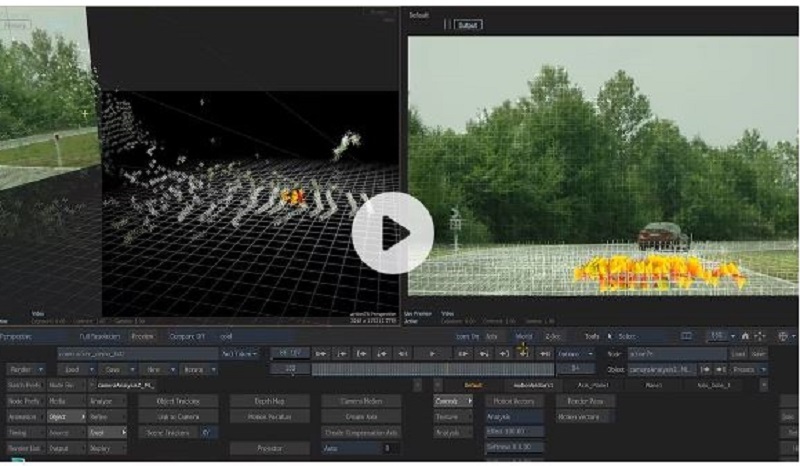As demand for high-quality content continues to rise, post-production houses are adopting cloud infrastructure and workflows to connect globally dispersed talent and scale for new creative and logistical challenges.
With the growing projects, lead artists have more stakeholders, tools, and data to juggle than ever before, accentuating the need for a connected, collaborative and creative solution that centralises finishing and VFX workflows. The latest updates to Autodesk Flame solidify its role as a centralised hub for conform, timeline, VFX, publishing, colour, and delivery.
A new metadata overlay feature lets artists view shot metadata in context, directly in the Flame viewer UI, providing easier monitoring and tracking of shots when collaborating across teams. With additional support for native Apple silicon, Flame artists can achieve new levels of performance on their hardware and software to meet growing demand for high-end episodic television, commercials, and feature films in shorter time frames.
“Our customers have less time to deliver more, high-end content than ever before,” said Autodesk senior product owner Stephane Labrie. “We’re focused on creating a hub at the heart of the finishing workflow so Flame artists can increase speed and efficiency across their workflows and better equip their teams to deliver more content faster on local solutions or in the cloud.”
Optimising finishing and VFX workflows in Flame:
The latest updates to Flame optimise desktop, hybrid and cloud finishing solutions and put new, creative tools in artists’ hands for a familiar and uncompromised experience.
- New hub capabilities support artists’ definable VFX shot Start Frame metadata, streamlining workflows, and better facilitating collaboration, regardless of the toolset used.
- Artists can leverage a new content-aware overlay menu to display clip metadata in context in the Flame viewer UI, save presets and share them, allowing for rapid, in-context viewing of current segment metadata. Additionally, multiple options have been added to the Burn-In Metadata tool, including Start Frame, Handles, Timeline FX, and Batch Iteration, to boost productivity and support more complex workflows.
- Batch Paint, one of the most widely used tools, is updated with the ability to apply changes to multiple strokes at once and track strokes directly within the Paint node. Other improvements include definable brush presets, a preference to set the default status of the Consolidate option, a cleaner user interface showing all controls, and increased stability, all aimed at improving the artist experience.
- The Flame Family of products now runs natively on the latest Mac computers and operating systems, enabling artists to harness the power of the latest generation hardware and software.
Embracing post-production in the cloud:
Extending cloud-enabled finishing capabilities introduced last year, the latest Flame updates reduce complexity for customers collaborating in the cloud, better equip distributed teams, and help studios meet increased demand during production spikes. With recently announced support for Amazon Web Services (AWS) Cloud Digital Interface (CDI), which allows users to move uncompressed video between AWS instances, Flame enables high-quality, low-latency reference monitoring when working in the cloud.
Flame AWS users can transmit 8-bit, 10-bit and 12-bit video signals with audio, accommodating better reference display and viewing needs for the most demanding projects virtually anywhere in the world. Paired with a supported streaming solution, signals can be sent to multiple devices, enabling remote work and collaboration with fellow artists and review stakeholders.
Studios are saving time and reducing budgets by running Flame on the cloud. Carbon leverages Flame for a majority of its 2D VFX finishing, title, compositing and editing work for commercial, music video and documentary projects. Although the studio presently has 25 Flame licences, its unique deployment lets the team easily scale the volume of active Flame workstations depending upon its project slate. Carbon’s entire Flame lifecycle is built into a GITLabs open-source product, so when new Flame updates are released, they are automatically made available to access the latest software versions.
“Being able to scale Flame workstations up and down as projects demand, and ensure we’re upgraded to the latest version of Flame automatically has been a true game-changer in terms of time and cost savings,” shared Carbon engineering head Dave Young. “We can spin up a Flame workstation and have an artist up and running in a third of the time it takes to do with a traditional on-premise set up. We have also engineered our cloud pipeline to automate archival of every project that Flame is responsible for, so our artists no longer have to babysit the archive and can simply log out at the end of the day, and we benefit from robust data protection. Everyone is thrilled with the setup and performance they are getting out of these workstations, plus the flexibility they provide.”
Additionally, Flame is qualified for use with LucidLink and Hammerspace cloud-based storage solutions, further empowering customers to move their productions to the cloud.
Connecting artists with their clients in Moxion Rooms:
Flame artists can take a direct NDI preview out of Flame into Moxion Rooms as a Live Asset through Moxion Connect. They can also leverage the Flame and Moxion API to send a Flame sequence to Moxion, bring it into a Room for review, and send a report of the review session back to the Flame artist.


